
Wernigerode is a town in the district of Harz, Saxony-Anhalt, Germany. Until 2007, it was the capital of the district of Wernigerode. Its population was 32,181 in 2020.
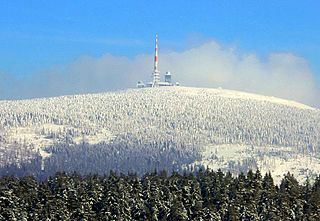
The Brocken, also sometimes referred to as the Blocksberg, is the highest peak in the Harz mountain range and also the highest peak in Northern Germany; it is near Schierke in the German state of Saxony-Anhalt between the rivers Weser and Elbe. Although its elevation of 1,141 metres (3,743 ft) is below alpine dimensions, its microclimate resembles that of mountains of about 2,000 m (6,600 ft). The peak above the tree line tends to have a snow cover from September to May, and mists and fogs shroud it up to 300 days of the year. The mean annual temperature is only 2.9 °C (37.2 °F). It is the easternmost mountain in northern Germany; travelling east in a straight line, the next prominent elevation would be in the Ural Mountains in Russia.

Brocken-Hochharz was a Verwaltungsgemeinschaft in the district of Harz, in Saxony-Anhalt, Germany. It was situated in the Harz mountains, southwest of Wernigerode. It was named after the highest peak of the Harz: Brocken. The seat of the Verwaltungsgemeinschaft was in Hasselfelde. It was disbanded on 1 January 2010, when most member municipalities merged into the newly formed town of Oberharz am Brocken, with the exception of Allrode.
Harz is a district in Saxony-Anhalt, Germany. Its area is 2,104.9 km2 (812.7 sq mi).

Wernigerode Castle is a schloss located in the Harz mountains above the town of Wernigerode in Saxony-Anhalt, Germany. The present-day building, finished in the late 19th century, is similar in style to Schloss Neuschwanstein, though its foundations are much older and have been reconstructed several times. Wernigerode Castle was first built at the beginning of the 12th century (1110-1120) as a Romanesque architecture medieval fortress for German emperors to have a secure spot to stop during their hunting trips to the Harz. Few of these medieval walls and foundation remain today. At the end of the 15th century the castle was enlarged in a Gothic architecture style, with large arched windows. During the 16th century, it was rebuilt as a Renaissance fortress. A spiral staircase tower still remains intact today.
The Hainleite is a Muschelkalk ridge of hills up to 463.2 m above sea level (NN) in northern Thuringia, Germany.

The Zeterklippen are a striking rock formation or tor on the 930-metre-high Renneckenberg mountain, overlooking the Ilse valley in the Harz mountains in Germany. The Renneckenberg is an eastern sub-peak of the Brocken. The rocks themselves lie at a height of about 830 metres (2,720 ft) above sea level. They can be reached from the Molkenhausstern after about 2.5 km. The track initially runs uphill through dense spruce forest until the view opens out towards the Hohnekamm and down to Wernigerode. Then the route branches off to the right onto a steep, 0.5 km, path and, after about 200 m, a gentler 0.4 km path leads to the Große Zeterklippe. Immediately below this highest of the rocks is a mountain hut that dates to the time when a botanical garden had been laid out here as a replacement for the inaccessible Brockengarten.
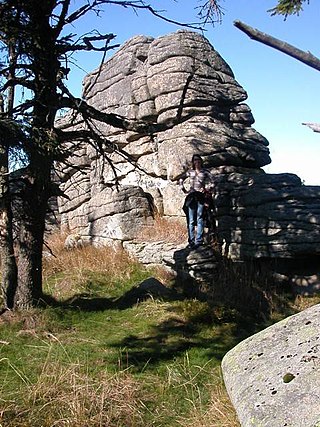
The Hirschhorn Rocks are a natural monument in the Harz National Park in central Germany.
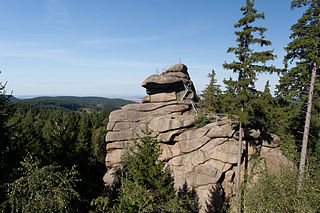
The Ottofels, named after Prince Otto of Stolberg-Wernigerode, is a tor and natural monument near Wernigerode in the Harz mountains of central Germany.

Drei Annen Hohne is the name of a small settlement within the municipal area of Wernigerode in Saxony-Anhalt, Germany.

Plessenburg is a village in the town of Ilsenburg in the Harz National Park, in the district of Harz in the German state of Saxony-Anhalt.
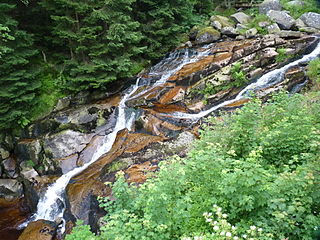
The Steinerne Renne is a waterfall and natural monument near the town of Wernigerode in the Harz mountains of central Germany.

Hasserode Castle in the quarter of the same name in the town of Wernigerode am Harz was a medieval fortification whose site is near Hasserode station on the Harz Narrow Gauge Railways. Today there are no visible traces left of the castle.
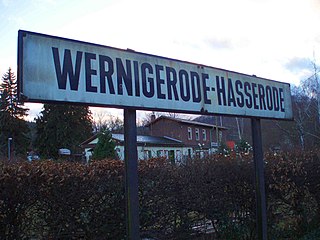
Hasserode has been a quarter in the town of Wernigerode in the German state of Saxony-Anhalt since 1907.
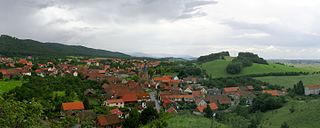
Benzingerode has been a village incorporated into the borough of Wernigerode since 1 April 1993. in the district of Harz in the German state of Saxony-Anhalt.

The Museum für Luftfahrt und Technik Wernigerode is an aviation museum located in the German town of Wernigerode near Halberstadt. Many aerospace exhibits are on display including fixed-wing aircraft, helicopters and aircraft engines. The main display is contained within two buildings with some aircraft displayed externally. In addition to the aircraft exhibits a number of cockpit sections and a collection of ejection seats are also held by the museum.
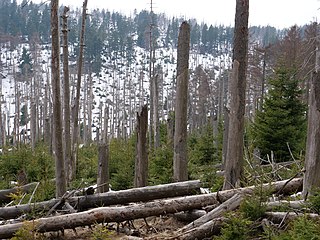
The Eckerloch is a forested mountain valley, 845 metres above sea level near the village of Schierke in the Harz Mountains of central Germany.

Poppenberg Observation Tower is a steel German lattice observation tower that is used for observation, at the same time, for communication. It is a truss tower located in the summit of Poppenberg. It is one of the oldest steel lattice towers in Germany and was built in the year 1897. It was later on refurbished in 1994. The tower was built by the Nordhausen branch of the Harz Club. The tower was also named after Otto, Prince of Stolberg-Wernigerode. It has an antenna that is 33 metres long.

The Austberg, also called the Augsberg or Augstberg, is a low hill, 292 m above sea level (NN), in the northern Harz Foreland near the village of Benzingerode in the district of Harz in the German state of Saxony-Anhalt.
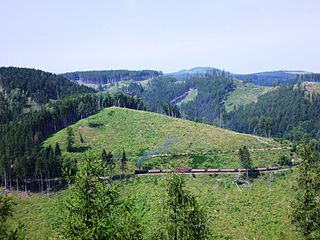
The Elversstein in the Harz Mountains of Germany is a granite rock formation with a maximum elevation of 499 m above sea level (NN) on the Steinberg near Hasserode in the county of Harz in Saxony-Anhalt.


















